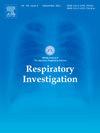Switching to tezepelumab from other biologics in patients with severe asthma: a retrospective study
IF 2
Q2 RESPIRATORY SYSTEM
引用次数: 0
Abstract
Background
Tezepelumab, an anti-thymic stromal lymphopoietin antibody, has shown efficacy in reducing exacerbations and improving control in patients with severe asthma (SA), including those with low type 2 (T2) inflammation. We aimed to evaluate the efficacy and safety of switching to tezepelumab in patients with SA that was inadequately controlled by previous biologics.
Methods
In this retrospective study, we included patients with SA previously treated with at least one biologic and subsequently switched to tezepelumab (210 mg every 4 weeks) for ≥24 weeks between December 2022 and December 2023. Clinical outcomes were evaluated using changes in Asthma Control Test (ACT) scores, oral corticosteroid (OCS) dose, pulmonary function, exacerbation frequency, and Biologics Asthma Response Score (BARS). Positive T2 biomarkers were defined as peripheral blood eosinophil count ≥150/μL, immunoglobulin (Ig) E > 167 IU/mL, or exhaled nitric oxide >25 ppb.
Results
Among 22 patients, 77 % were exacerbation-free after 12 weeks, and 64 % were classified as responders (ACT score increase ≥3). Remission (ACT ≥23, no exacerbations, steroid-free) was achieved in 18 %. ACT scores, forced expiratory volume in 1 s (FEV1; median +40 mL, p = 0.0413), and OCS doses significantly improved. According to BARS, 41 and 41 % had “Good response” and “Response,” respectively. Improvements were observed in patients switching from anti–IL-5 agents and dupilumab; however, benefits varied by prior biologic.
Conclusions
Tezepelumab may be effective for patients with SA who could not respond to other biologics. Further studies are warranted to evaluate long-term outcomes and optimal patient selection.
严重哮喘患者从其他生物制剂转向tezepelumab:一项回顾性研究
tezepelumab是一种抗胸腺基质淋巴生成素抗体,在严重哮喘(SA)患者(包括低2型(T2)炎症患者)中显示出减少加重和改善控制的疗效。我们的目的是评估在先前的生物制剂不能充分控制的SA患者中切换到tezepelumab的疗效和安全性。在这项回顾性研究中,我们纳入了先前接受至少一种生物制剂治疗的SA患者,随后在2022年12月至2023年12月期间切换到tezepelumab(210 mg / 4周)≥24周。通过哮喘控制试验(ACT)评分、口服皮质类固醇(OCS)剂量、肺功能、加重频率和生物制剂哮喘反应评分(BARS)的变化来评估临床结果。T2阳性生物标志物定义为外周血嗜酸性粒细胞计数≥150/μL,免疫球蛋白(Ig) E >; 167 IU/mL,或呼出一氧化氮>;25 ppb。结果22例患者中,12周后77 %无加重,64 %为缓解者(ACT评分升高≥3)。缓解(ACT≥23,无加重,无类固醇)达到18% %。ACT评分,1 s用力呼气量(FEV1;中位数+40 mL, p = 0.0413), OCS剂量显著提高。根据BARS,分别有41%和41% %的人有“良好反应”和“反应”。在从抗il -5药物和杜匹单抗切换的患者中观察到改善;然而,益处因先前的生物学而异。结论stezepelumab可能对其他生物制剂无应答的SA患者有效。需要进一步的研究来评估长期结果和最佳患者选择。
本文章由计算机程序翻译,如有差异,请以英文原文为准。
求助全文
约1分钟内获得全文
求助全文

 求助内容:
求助内容: 应助结果提醒方式:
应助结果提醒方式:


